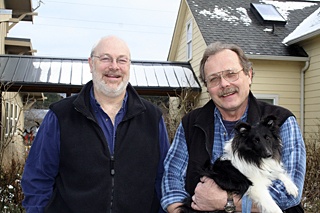Paul Kamin expected to get better television reception with his new digital-to-analog converter box. What he didn’t expect: fewer channels.
After installing his box – one option for viewers preparing for the switch to digital television signals – the Orcas resident was unable to receive Seattle’s ABC, NBC or CBS stations.
“I only get the Seattle Fox station and the Bellingham independent station,” said Kamin, who has written to Congressman Rick Larsen about the problem.
“It is unfortunate that this ‘upgrade’ in television service is not benefiting everyone, and worse, is adversely impacting some,” he said.
The switch from analog to digital broadcast television has been a long time coming.
Congress first issued the distribution of a digital channel to each broadcast TV station in 1996. Stations continued their analog broadcasts while starting a digital channel at the same time.
But the end is near. Congress has set June 12, 2009 as the final date that full power television stations can broadcast analog signals – at all.
After that date, full power television stations will only broadcast digital, over-the-air signals. Some broadcast television stations already made the transition on Feb. 17.
Digital television is touted as an “advanced broadcasting technology that will transform your television viewing experience” by the official DTV government site.
But for those who don’t want to buy a digital television set or get their TV from rabbit ears, the picture hasn’t been so rosy.
Although consumers have been given the option to connect to a digital-to-analog converter box, which decodes the DTV signals to an analog TV, the transition hasn’t been very successful for some Americans. And Orcas is no exception.
Kyle Koepcke, who works at Radio Shack on Orcas, says the feedback he’s received is pretty negative.
“Unless you have a clear line of site to Seattle, people are not going to be getting the channels they are expecting. Digital signals are very short and they don’t go over the mountains the way analog signals do. The government didn’t really think this out very well, because people in these rural places without big antennas are going to be disappointed with the signal. It works fantastic for people in the cities. But it’s iffy for us out here,” Koepcke said.
Gene Nery, also of Radio Shack, suggests investing in a roof antenna if your signal strength is weak, but “the bottom line is that there is no guarantee. Digital signals are highly susceptible to obstruction.”
But for some locals, the transition has been an improvement.
Ted Wixom, who works at Eastsound Water Users Association with Kamin, says he is receiving nearly double the number of channels on his analog TV with a converter box and an antenna.
“Every channel I get now is very clear,” Wixom said. “I live in Doe Bay and look directly south down the channel, so I have a straight shot at Seattle. A lot of stations before that were marginal are now coming in clear. And I went from 12 to 25 stations total. I was on the verge of buying a new flat screen, but I just saved a bunch of money.”
To check your location for signal strength of free TV, see www.tvfool.com. Locally, Radio Shack carries the converter boxes. For more information about the analog to digital switch, see www.dtv.gov.



